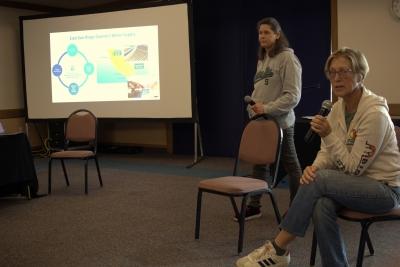
Story and photos by Karen Pearlman

Photo, left: Padre Dam Municipal Water District board members Kim Hales (who represents Alpine) and Suzanne Till share information with ratepayers on Sunday afternoon, March 30, at The Alpine Club.
April 1, 2025 (Alpine) – Just a few days before San Diego County Water Authority will give presentation to the Padre Dam Municipal Water District Wednesday about wholesale water rates in 2026 and 2027, Alpine residents gathered to share some concerns about rate increases, as well as fire safety and water purification.
Two Padre Dam directors spoke Saturday at The Alpine Club. Alpine resident Anne Craig spearheaded the March 30 visit that brought Dr. Suzanne Till, who serves in Padre Dam’s Division 2 area, and Kim Hales, who oversees Division 4, including Alpine.
On Wednesday, Dan Denham, general manager of SDCWA will be talking about "Wholesale Water Rates: Strategies for Long-Term Stability at Padre Dam’s Wednesday meeting at its facility outside of Santee Lakes Recreation Preserve.

Photo, right: James Thomas asked questions about billing cycles for Padre Dam Municipal Water District
“I was the one that asked them to come out here and try to get as many people to come,” Craig said of the directors who spoke on Saturday. “It’s really funny. Everybody’s willing to complain about water and the cost but they’re not really willing to come and listen to what the governments are doing and that’s a bit frustrating too.”
Is there enough water to fight a wildfire?
While the cost of water is about to rise, wildfire danger is high on the list of concerns for Alpine, which has been hit several times in recent years with major blazes.
After the fiasco with the wildfires in January that hit Los Angeles County -- where water was not always available and a reservoir was empty – people are taking a closer look at what their needs would be in case a similar incident happens in East County.
Hales and Till told Alpine residents that they are as protected as can be.
Hales reminded residents that in the last electrical shutdown in Alpine, the town did not lose its water.
“They have backup generators in order to keep the water flowing out here because Padre Dam also understands if the fires are up here, firefighters need that water as well as the residents,” Hales said. “They’re equipped with backup generators, and I think back up to the backup as well, so they were forward thinking on that.”
Till said that Padre Dam takes extra steps when a Santa Ana weather pattern is expected in the region.
“If the fire danger is extreme, we pump up extra water up into this area,” Till said. “And then when we talk about the actual pumping infrastructure, there are many redundancies. Let’s say a pipe burst or something goes down, we have multiple ways to get water up here.”
The Cycles of Billing
James Thomas, who said he’s been a resident of Alpine since 1973, asked Till and Hales why the district’s billing cycles are not consistent. He said some cycles include an extra week, putting him into a higher tier, resulting in higher rates.
Till has been on the Padre Dam board since 2020 and said that when she was first running for a seat, she learned that the district’s billing cycle is a top question residents.
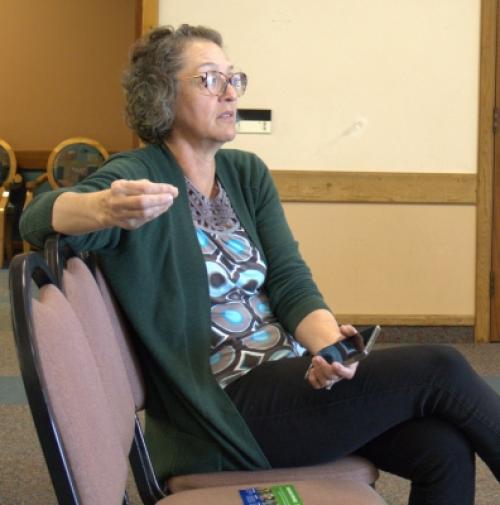
Padre Dam water rates increase with each of three different tiers. Each tier is incrementally higher and based on specific allotments. Residential water rates in Tier 1 are $9.06 per hundred cubic feet of water (where one HCF is 748 gallons); Tier 2 is $10.23 per HCF and Tier 3 is $11.76 per HCF.
Photo, left: Anne Craig organized the forum to make sure Alpine residents are able to have their voices heard.
“The way the rates are structured is you get X amount of water in Tier 1,” Thomas said. “For X amount of money you get into Tier 2 the price goes up. You get into Tier 3 and the price goes up even greater. The billing cycles are not uniform… 365 divided 12 is 30.41, but my billing cycles are 28 and then the next month it's 35 and then it's another number and another number. When you get into a billing cycle that’s 35 days as compared to 28, you’re gonna get in the next tier, you’re gonna pay more money. It’s simple math to me 365 divided by 12.”
Till said she will be meeting with Padre Dam General Manager Kyle Swanson this week to request that the concern be brought up on a future board agenda. She and Hales suggested that concerns like that be shared by constituents in an email to the district.
Getting Water Up and Water Rates Going Up
Anyone who’s lived in California or owned property in the state knows that water in Southern California comes with a hefty price, and one that’s about to go up again.
The costs of water in San Diego County, which by population is the state’s second largest county, are some of the highest around.
The San Diego County Water Authority notified residents that water rates will soar about 14% this year. The increase in rates is related to water treatment, water supply reliability, and water purchases largely tied to importing water. SDCWA imports the majority of the county’s water from outside the region and charges “pass-through costs.”
Last year, the Metropolitan Water District of Southern California adopted a two-year budget with rate increases of 8.5% in both 2025 and 2026, with the rates for treated water going up 11% this year and 10% next year.
“Everybody should be able to afford safe clean drinking water we should not have to go through this,” Till said. “And we’re talking 20% rate hikes of what’s projected 39.4 rate hikes over the next three years. That’s the reality of it… County Water Authority is around 39% rate percent rate hike for everybody in San Diego County over the next three years.”
Till said that while water rates are about to increase, she cautioned residents to “remember it does cost money to run those generators, it does cost money to run those pumps, it does cost money to put in (built in backups).”
“It’s not that we’re just providing your water, and for some people sewer, but we’re also assisting with protection for fire safety, too,” she said.
Till said Padre Dam relies 100 percent on imported water but to help allay the costs and take control of its own water supply, Padre Dam has been working on the East County Advanced Water Purification Program. (AWP) It has been partners with Helix Water District, the city of El Cajon and the County of San Diego on the project for a decade.
Planned to go online in late 2026, Padre Dam started the process with a demonstration facility that started operating at Santee Lakes in 2015.
The East County AWP will purify recycled water using advanced technologies like membrane filtration, reverse osmosis and advanced oxidation, ultimately producing near-distilled water. That water will then be blended with water in Lake Jennings, the reservoir overseen by Helix Water District, and treated again before being distributed as drinking water.
The project is one of the first surface water augmentation projects in California. When completed, it is expected to be able to provide 30 percent of Padre Dam's water supply locally.
Sourcing Energy from Bacteria
Another component leading to higher rates is the costs of electricity through San Diego Gas & Electric, Till said. The AWP plant will have its own energy source, so the district won’t have to rely on SDG&E.
The AWP’s final component involves the construction of a $50 million energy recovery system that will produce two megawatts of renewable energy generated from digester biogas and organic waste.
Hales, who is a biologist, said the energy source is part of its purification process, involving the bacteria that helps to break down the organics.
“Bacteria release gases and many industries will tend to use those gases, you know CO2 and that kind of thing, they tend to just burn it,” Hales said. “Instead of burning it off, those gases can be used for power. And so it’s being put back into the system as a power source. It’s a pretty slick system and because it’s locally controlled water, there’s a little more control over where money is being spent.”
Expected to be complete in 2028, the system will supply up to 40 percent of the electricity for the AWP’s water recycling facility as well as a solids handling facility, a product water pump station and a new Education Center.
County’s Planning Group to hear controversial proposal on April 18
Story and photos by Karen Pearlman
Photo,left: Valle de Oro Community Planning Group members during packed hearing on Cottonwood Sand Mine
March 20, 2025 (Rancho San Diego) – More than 100 residents who would be most affected by the proposed Cottonwood Sand Mine gathered in force Tuesday, March 18 at the Rancho San Diego Library to let the Valle de Oro Community Planning Group know they don’t want it in their neighborhood.
After listening to more than two dozen people share their concerns, the community planning group voted 11-0 to recommend opposing the project that would see 214 acres of the former 280-acre Cottonwood Golf Course along Willow Glen Drive in Rancho San Diego turned into a digging site for sand mining for at least 10 years.
The group also voted 10-1, with one abstention, to not agree with a design exception review to waive the undergrounding overhead utilities along Willow Glen Road.
Next step: County Planning Commission hearing April 18
Oday Yousif, chairman of the Valle de Oro planning group, said he would be submitting a formal recommendation on behalf of the organization and those it serves, to not approve the sand mine Major Use Permit application to the San Diego County Planning Department by the March 23 due date before the item is heard at the April 18 meeting.
That recommendation, along with a recommendation from the county’s Planning Department Services, will be presented to the county’s five-member Planning Commission. The County Planning Commission will then decide on whether to approve or not approve the sand mine operation permit application.
The County Planning Commission meets monthly to consider land use projects affecting unincorporated areas of the county. Its next me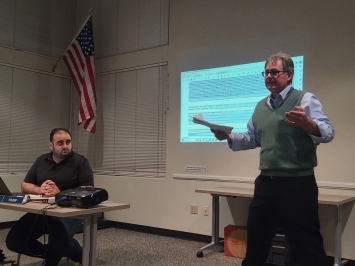 eting is March 21, but the meeting for the sand mine item has been set for 9 a.m., Friday, April 18 at the County Operations Center Hearing Room on Overland Drive.
eting is March 21, but the meeting for the sand mine item has been set for 9 a.m., Friday, April 18 at the County Operations Center Hearing Room on Overland Drive.
Photo, right: Valle do Oro Community Planning Group Chair Oday Yousif, left, looks on as County Land Use Planner Chris Jacobs gives presesntation.
Residents share concerns during crowded meeting
Residents at the meeting expressed concerns ranging from environmental, health and safety issues related to the silica dust being kicked up during the process, as well as traffic impacts, especially for emergency safety needs. Among those there to listen was applicant representative Brice Bossler and County Land Use Planner Chris Jacobs.
San Miguel Consolidated Fire Protection District Director Theresa McKenna said that in 2022, then-Fire Chief Criss Brainard provided comments the county on the district’s concerns about the project related to emergency response time delays.
“Increased heavy truck traffic and slowing during construction all have the potential of increasing emergency response times,” McKenna said. “In our letter to the County, the Fire District requested health and safety concerns be mitigated for the benefit of the community, since even short delays can mean the difference between life and death.”
Detractors say that the project is inconsistent with both the County General Plan and Community Specific Plan. The Rancho Specific Plan identifies the golf course serving as a buffer area and providing a larger setback to sensitive habitat areas.
They also say that a final Environmental Impact Report has not been shown, so they are working off information culled from the Draft EIR, first circulated in 2021.
The site is in the middle of the Rancho San Diego region, and shares borders with homes, and is near schools and businesses.
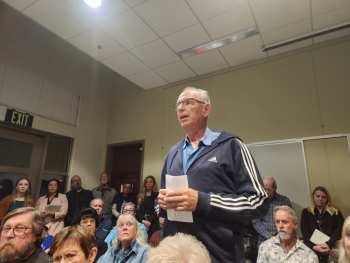 Dr. Bob Foster (photo, left), a retired physician, said he is “extremely concerned about the negative health effects of this sand mine idea.”
Dr. Bob Foster (photo, left), a retired physician, said he is “extremely concerned about the negative health effects of this sand mine idea.”
“I’m adamantly opposed to it,” Foster said. “I think it's a horrendous plan that this is come up with and I want to be clear that we’ve got to do everything we can to stop this from ever becoming a reality. It’s a danger to those kids who have to walk to school every day across the clouds of smoke and sand that are going to be expelled from the sand mine operation. It’s just appalling to me that this plan has actually gotten to this level.”
The site also runs along the Sweetwater River watershed --a nearly 230-square mile region that goes from the Cuyamaca Mountains out to San Diego Bay. Groundwater from its lower basin is also linked to the watershed. The site is upstream from a federal wildlife preserve.
Sweetwater Authority, which oversees the water in the region, has expressed concern in the past about the project’s impact on water levels and quality.
Josan Feathers (photo, right), a registered Civil Engineer and member of the Valle de Oro Cottonwood Subcommittee, posed 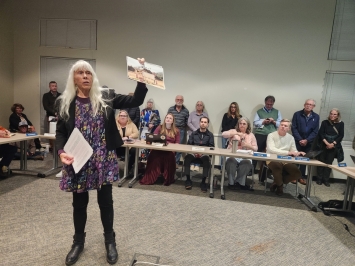 some rhetorical questions to those in attendance.
some rhetorical questions to those in attendance.
“Would you trust an applicant or engineers who missed the need for an additional 3.5 million tons of backfill? Would you trust the same applicant to excavate 79 acres downstream of the 30-year-old Steele Canyon Bridge (in Jamul) and about 100 acres upstream up to 40 feet below the ground surface?”
Feathers said that the development proposes to backfill the river “with excavated materials they can’t sell.”
“This project can potentially taint and pollute the drinking water that flows into the Sweetwater Reservoir which serves almost 200,000 South Bay residences, potentially endangering and impacting them, as well as the wildlife in the area,” she said.
The developer’s view
The developer of the land at the golf course, New West Investment, has said previously that the project is needed to supply sand for local building and infrastructure projects, and its presence will mean avoiding the cost of importing sand.
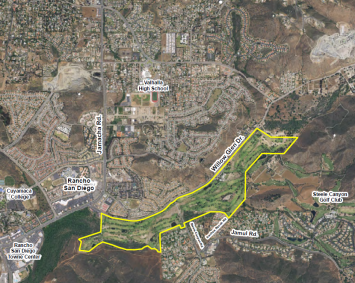 Areas included within the project boundary that are not disturbed by mining would be subject to habitat improvement through removal of invasive species in the river channel (if necessary) or would be left in their current condition including the existing Sweetwater River channel. (See map of project site, left)
Areas included within the project boundary that are not disturbed by mining would be subject to habitat improvement through removal of invasive species in the river channel (if necessary) or would be left in their current condition including the existing Sweetwater River channel. (See map of project site, left)
The project would also make certain improvements to Willow Glen Drive prior to beginning mining operations.
New West Investment and Los Angeles-based investor Michael Schlesinger purchased Cottonwood in 2015, four years after the golf course filed for Chapter 11 bankruptcy.
Representatives for the project were asked to weigh in the following day, and provided only a brief statement.
“The Cottonwood Proposal would ultimately transform a defunct golf course property into 200 acres of permanent, preserved open space for the community to enjoy,” the statement reads.
“In the near-term, it would provide critically needed sand supplies for housing and infrastructure projects through a phased approach that reduces community concerns around views. Creating a local sand supply at Cottonwood is a win for the San Diego region because it would reduce the increased costs and environmental damage caused by trucking sand in from outside the region and Mexico.”
Schlesinger has been planning to mine the site of the former Cottonwood Golf Course since 2018. He bought the property in 2015.
He had also purchased the Escondido Country Club in 2012, then shut down the golf course and worked to build nearly 400 homes on the site. Involved in several legal battles related to that, the homes were eventually built and are now known as the master planned Canopy Grove.
What happens if it’s approved?
While the new EIR has not been released, as originally filed, the proposal explains the plan to mine 4.7 million cubic yards with nearly 3.8 million cubic yards (or 5.7 million tons) of washed concrete sand (construction aggregate) produced over 10 years. It will be done in phases with reclamation planned after each phase for a total of 12 years of activity.
The extraction process would occur in three phases over the span of 10 years and the cleanup, equipment removal and final reclamation would occur in the fourth phase over two years.
Sand excavation and processing would occur between 7 a.m. and 5 p.m. Monday through Friday, with trucking operations for material sales and backfill import from 9 a.m. until 3:30 p.m. Monday through Friday.
Stop Cottonwood group mobilizes opposition
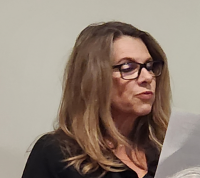 Elizabeth Urquhart, who has spearheaded the Stop Cottonwood Sand Mine efforts, spoke passionately at the meeting and presented evidence she said “shows the continued sand mine Major Use Permit application is unsuitable for approval” based on myriad factors, “including impacts on the surrounding environment neighborhood character and public facilities.”
Elizabeth Urquhart, who has spearheaded the Stop Cottonwood Sand Mine efforts, spoke passionately at the meeting and presented evidence she said “shows the continued sand mine Major Use Permit application is unsuitable for approval” based on myriad factors, “including impacts on the surrounding environment neighborhood character and public facilities.”
The stopcottonwoodsandmine.com site has been active since the beginning of the issue, and through its work, a large number of Rancho San Diego’s nearly 21,000 residents have signed petitions and have packed public meetings through the years to oppose the project.
After the meeting, Rancho San Diego resident Anne-Marie Jacques said residents “feel like the developers don’t give a crap that this project just doesn’t make sense in this community, and they’re hoping we just give up.”
“Communities like RSD don’t need a sand mine because it wouldn’t add anything of substance or value to us,” she said. “They’re only looking out for their bank accounts not the people who live, work and go to school in the area.”
Fire safety and water purification among top issues to be discussed
East County News Service
March 15, 2024 (Alpine) - Alpine resident Anne Tillmond is hosting a Town Hall Q&A featuring Padre Dam Municipal Water District Board Members Kim Hales (Division 4) and Dr. Suzanne Till (Division 2) on March 30 from 2:00 p.m. – 3:30 p.m. at the Alpine Club – 1830 Alpine Blvd. Alpine, CA 91901.
Padre Dam Municipal Water District Board Members Kim Hales and Dr. Suzanne Till welcome attending community members and customers to answer questions and discuss fire safety, engineering, planning, advanced water purification and more. The Alpine Club, formerly the Alpine Community Center, will open its’ doors for the Town Hall starting at 2:00 p.m.
Director Till (Vice President of PDMWD, photo top left) was elected to her first four-year term in November 2020. She has lived in Santee since 1991, and advocates for affordable drinking water for Santee residents and water sustainability. She served as a Captain in the United States Marine Corps. Suzanne has a Ph.D. in Water Resources Geography from the University of Colorado, Boulder, and a Masters in Geography and Urban Planning from San Diego State University.
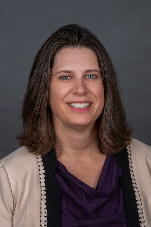 Kim Hales (left) moved to San Diego from Michigan in 1996 to attend graduate school at SDSU during which time she worked at the San Diego Zoo to help pay for college. Kim holds a BS degree in Zoology and a Master’s Degree in Animal Behavior and has been a biology professor at Cuyamaca College for over 21 years. For the last 10 years she lives in Alpine where she owns and maintains a ranch with her husband, a retired US Navy Captain.
Kim Hales (left) moved to San Diego from Michigan in 1996 to attend graduate school at SDSU during which time she worked at the San Diego Zoo to help pay for college. Kim holds a BS degree in Zoology and a Master’s Degree in Animal Behavior and has been a biology professor at Cuyamaca College for over 21 years. For the last 10 years she lives in Alpine where she owns and maintains a ranch with her husband, a retired US Navy Captain.
By Leorah Gavidor
March 13, 2025 (Campo) -- When Urban Timber partners Jessica Van Arsdale and Dan Herbst learned they had just a few months to move their well-established tree salvage business, the couple had to scramble to find a place to move hundreds of tons of logs that they had saved from the landfill. The company that saves trees from urban displacement was itself facing displacement. After a few weeks of major stress and uncertainty, Urban Timber found its rural salvation in East County.
Van Arsdale and Herbst found a 13-acre piece of land listed for sale in Campo, and then they found real estate agent Carol Snyder. She championed the purchase knowing Urban Timber’s plans for the property were to bring new business and new energy to the town. The vision is to build community in Campo, with resources, materials, and tools on site for artists and woodworkers to design and build projects using salvaged wood from around San Diego County.
“Each time I get to visit I'm amazed at the progress Dan has made in the shop and the outbuildings. Dan is one of a few true craftsmen left in this world. Jessica, with her hard work and artistic finesse has transformed the house into a cozy, welcoming home … you can be assured this property will be a showplace in a short time,” said Snyder.
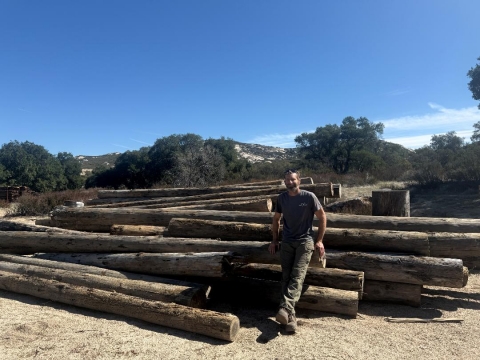 In its previous location, Urban Timber transformed a blighted piece of land on Bay Boulevard in Chula Vista into a hub for an artistic and sustainable-minded community where trees came to be upcycled and people came to turn imagination into reality. Through partnerships with the city, word of mouth, and a network of tree-lovers, the business amassed a beautiful collection of logs that would have otherwise gone to the woodchipper but instead were turned into custom furniture, shelving, siding, benches, sculptures, and even a one-of-a-kind Fender guitar called the “Timbercaster.”
In its previous location, Urban Timber transformed a blighted piece of land on Bay Boulevard in Chula Vista into a hub for an artistic and sustainable-minded community where trees came to be upcycled and people came to turn imagination into reality. Through partnerships with the city, word of mouth, and a network of tree-lovers, the business amassed a beautiful collection of logs that would have otherwise gone to the woodchipper but instead were turned into custom furniture, shelving, siding, benches, sculptures, and even a one-of-a-kind Fender guitar called the “Timbercaster.”
“We are so thankful to be here in Campo,” Van Arsdale said. “It feels like our future came and got us, and took us here, to a place we can stay and call home, and retire someday.”
But retirement is way off for the couple, who have big plans for their new home. Now that all the wood has been transported from Chula Vista to Campo—a feat that took two weeks, five 38-foot dump trucks, and several 48-foot flatbeds—Herbst said they will “put down good roots and branch out.”
“Maybe we can have demonstrations, tours, info sessions, workshops, art classes. We want to host landscape architects, designers, builders. Soon we’ll create a living catalogue of our landscape design materials. We want to put all this material and space to use,” said Van Arsdale.
There’s redwood from Balboa Park, bunya-bunya from UCSD, various eucalyptus that had to be cut down due to age or development, and much more. Herbst is also looking forward to the opportunity to use wood from fallen oaks, which he couldn’t use while in the city: oak can’t be transported due to spread of oak borer beetles. He had heard of oak removals around the county but had not been able to salvage them. Now he can collect local fallen oaks and dry them in his kiln to kill the bugs before using the wood.
 For now clients can visit Urban Timber by invitation; eventually the wood catalogue will be organized in a more shop-ready format, or possibly showcased locally in partnership with Campo businesses, so customers can see what’s available. With kilns and mills on site, logs can be dried, cut, and fashioned for various purposes. Lumber and cut pieces are also still for sale at Urban Timber’s separate woodshop location on Industrial Boulevard in Chula Vista, where the business will continue to maintain a presence as it transitions to home-based in Campo.
For now clients can visit Urban Timber by invitation; eventually the wood catalogue will be organized in a more shop-ready format, or possibly showcased locally in partnership with Campo businesses, so customers can see what’s available. With kilns and mills on site, logs can be dried, cut, and fashioned for various purposes. Lumber and cut pieces are also still for sale at Urban Timber’s separate woodshop location on Industrial Boulevard in Chula Vista, where the business will continue to maintain a presence as it transitions to home-based in Campo.
Van Arsdale is especially excited about forging partnerships with local businesses and organizations. Liberty Rising Healing Sanctuary of Boulevard came to the property to set the right vibe for moving in, and Rose Acre Farms was also on the welcoming committee. They’ve met their neighbor who keeps a donkey and rides his horse to visit friends, and befriended staff at East County Lumber and Feed.
“We want to do this in a considerate way,” said Dan. “We’re not coming here with deep pockets and a splashy mansion. We want to stay in rhythm with nature. The first step in permaculture is observation.”
As Urban Timber gets its footing in Campo, Van Arsdale and Herbst see the business as an integral part of the town’s economy.
“But I think we’ll need a new name,” Van Arsdale said. “Not-So-Urban Timber?”
East County News Service
February 28, 2025 (Jamul) – Jamul Casino will open the doors to its high-rise boutique hotel tower this spring, featuring 200 rooms, 52 spacious guest suites, 360-degree views and a curated collection of leisure experiences.
"This all-new hotel represents a proud moment in our tribe's journey and further supports our continued dedication to self-sufficiency," said Erica M. Pinto, Chairwoman of the Jamul Indian Village. "We’re not just transitioning from Jamul Casino to Jamul Casino Resort – we're building a legacy that honors our community while inviting visitors to experience the beauty and hospitality of our ancestral lands."
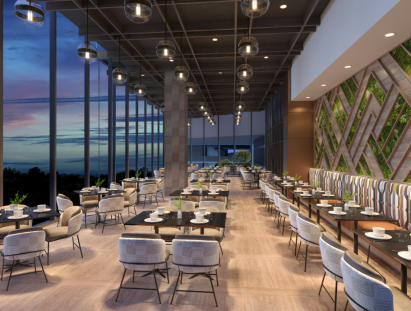 The 16-story hotel tower was originally imagined as a crystalline jewel box floating against the Jamul mountains, ultimately allowing visitors to now stay where they play. Guests will have access to the state-of-the-art hotel and its offerings through a climate-controlled, enclosed pedestrian sky bridge. The rooms’ sleek and elegant design creates a calming place of tranquility with one-of-a-kind views.
The 16-story hotel tower was originally imagined as a crystalline jewel box floating against the Jamul mountains, ultimately allowing visitors to now stay where they play. Guests will have access to the state-of-the-art hotel and its offerings through a climate-controlled, enclosed pedestrian sky bridge. The rooms’ sleek and elegant design creates a calming place of tranquility with one-of-a-kind views.
The all-new boutique hotel tower at Jamul Casino Resort aims to earn the AAA Four Diamond Rating – North America’s premier hotel rating program recognizing the most important aspects of luxury such as cleanliness, comfort, cuisine and consistency.
Among the many amenities will be an approximately 4,800-square-foot restaurant with sweeping views of the surrounding area, retail space, meeting and banquet facilities, a full-service spa and salon with an outdoor deck, a fitness center, and an 11,000-square-foot rooftop pool deck with a jetted hot tub, cabanas and a rooftop bar.
"We are thrilled to unveil this beautiful new hotel that our guests have been eagerly anticipating," said Mary Cheeks, President and General Manager of Jamul Casino. "With exceptional dining destinations, wellness-focused amenities, and curated experiences, we have created a space that truly caters to gaming enthusiasts, business professionals, and leisure travelers alike. We invite all guests to visit, unwind, play, and discover the very best of San Diego.”
 Opened in 2016, the Jamul Casino is owned and operated by Jamul Indian Village Development Corporation (JIVDC), a wholly owned enterprise of the Tribe. The $430 million, award-winning casino features nearly 1,700 slot machines, 46 live table games, a dedicated poker room, and various restaurants, bars and lounges.
Opened in 2016, the Jamul Casino is owned and operated by Jamul Indian Village Development Corporation (JIVDC), a wholly owned enterprise of the Tribe. The $430 million, award-winning casino features nearly 1,700 slot machines, 46 live table games, a dedicated poker room, and various restaurants, bars and lounges.
Jamul Casino supports more than 1,400 permanent jobs throughout the region and is the closest casino to downtown San Diego, which is the eighth-largest city in the United States by population.
To learn more about Jamul Casino, visit www.jamulcasino.com.
East County News Service
February 24, 2025 (Dulzura) – A Lakeside woman, 60, was killed in a collision that occurred yesterday on State Route 94 west of Marron Valley Road in Dulzura.
The victim was riding a 2019 Can Am 3-wheel motorcycle westbound on the highway when a 2024 Subaru Crosstek entered the westbound lane from a dirty driveway at 17771 State Route 94. The Subaru was driven by a San Diego woman, 29, who had a passenger, 31, also from San Diego.
“For reasons still under investigation, the Subaru and the Can Am crashed within the westbound lane, causing the rider of the Can Am to be ejected,” says Officer Jasmine Lopez with the California Highway Patrol. “The rider of the Can Am motorcycle succumbed to her injuries and was pronounced deceased on scene by medical personnel.”
The driver and passenger of the Subaru were uninjured.
This is an ongoing investigation, and it is unknown at this time if drugs and/or alcohol were a factor in the crash, Officer Lopez said.
By Miriam Raftery
February 20, 2025 (San Diego’s East County) – The County-run safe parking site on Magnolia in unincorporated El Cajon, one of two East County sites set up to help homeless people living in their vehicles, is temporarily closed for renovations. The improvements will include picnic and meeting areas, a dog run, improved bath and shower areas, and permanent structures to house staff offices,
“The site is anticipated to reopen in summer 2025,” says Fernando Lopez, group communications officer for San Diego County’s Health and Human Services Agency. “People experiencing homelessness and their vehicles are currently being served at Bancroft Safe Parking,” which is located in Spring Valley.
The El Cajon site opened in 2022. The Bancroft site opened in August 2024 and has space for 27 cars to park overnight, starting at 5 p.m. The site has security, along with clean restrooms, hot showers, a small kitchen and a dog run for people with pets. Dinner and breakfast are provided.
The lot is operated by County contractor Dreams for Change.
Those in the program are also paired with a Dreams for Change case worker to help them find housing options.
Gillie and Henry drove their black sedan onto the County’s Bancroft Safe Parking site in Spring Valley in January and since then, they say they have been able to breathe a sigh of relief.
The couple spent months staying at various shelters or sleeping in their car on the side of the road, after increased rent and a job loss forced them out of their long-term rental apartment and into their vehicle.
“No matter how we tried to keep our boat afloat, it was impossible,” Gillie explained, County News Services reports. She says being at Bancroft Safe Parking “makes a whole world of difference to know that at five o’clock, we can come here, we get a shower, there’s a heater, there is coffee, oatmeal for the morning. It’s a relief.”
Gillie and Henry were referred to Bancroft Safe Parking by a County Office of Homeless Solutions outreach worker.
“Safe parking lots provide people with a place to park and sleep for the night, without the risk of being towed or asked to move,” said Dijana Beck, Director of the County Office of Homeless Solutions. “Participants also have support to get things like documents in order, reunifying with family and of course finding a more permanent housing solution.”
The goal is to help the families, couples, and other people find more stable housing. Pets are welcome, too. On average, residents stay at Bancroft Safe Parking between three to six months.
For Gillie and Henry, their wait is over as they move into a studio thanks to support from the program.
The County’s Bancroft and Magnolia Safe Parking sites are part of County’s broader efforts to expand emergency housing options for people experiencing homelessness in the unincorporated communities.
Next up, the County aims to open Troy Street Sleeping Cabins in Lemon Grove in 2026.
Learn more about programs and resources on the County’s Office of Homeless Solutions website.
East County News Service
February 20, 2025 (Alpine) – Alpine Country Crafts and Gifts (2156 Alpine Blvd. in Alpine) invites you to a Spring Festival and Easter Celebration.
The event takes place on:
Thursday, March 20 4 p.m. to 7 p.m.
Friday, March 21 9 a.m. to 6 p.m.
Saturday, March 22 9 a.m. to 4 p.m.
- Public computers plus laptops for checkout
- High speed internet access and Wi-Fi throughout the branch
- Community Room with after-hours access for community events
- Teen area with study rooms
- Children’s area with early literacy play equipment
- Patio space and a Friends of the Library Bookstore
- Designated parking lot
By Miriam Raftery
February 19, 2025 (Spring Valley) – David Ruiz, 22, was arrested by Sheriff’s deputies today for the murder of his newborn son.
Responding to a 1:20 p.m. report of battery at a home on Sacramento Avenue in Spring Valley, San Miguel Firefighters arrived at 1:26 p.m., followed closely by Sheriff’s deputies from the Rancho San Diego station. “Firefighters discovered a newborn male infant unconscious on the living room floor, suffering from apparent trauma to his head. Tragically, the baby was pronounced dead at the scene,” says Lieutenant Michael Krugh.
The biological father, 22-year-old David Ruiz, was taken into custody and will be charged with the murder of his newborn son.
The motivation and circumstances surrounding this tragic homicide are still unclear. Sheriff's Homicide investigators are working to gather more information to determine the facts of the case.
Anyone with information about this incident is asked to call the Homicide Unit at (858) 285-6330/after hours at (858) 868-3200. You can remain anonymous by calling Crime Stoppers at (888) 580-8477.
